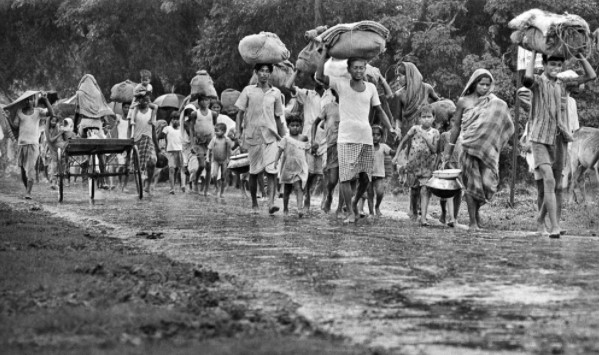1971 War in the Eastern Front - Part 2
Planning, deployments and execution
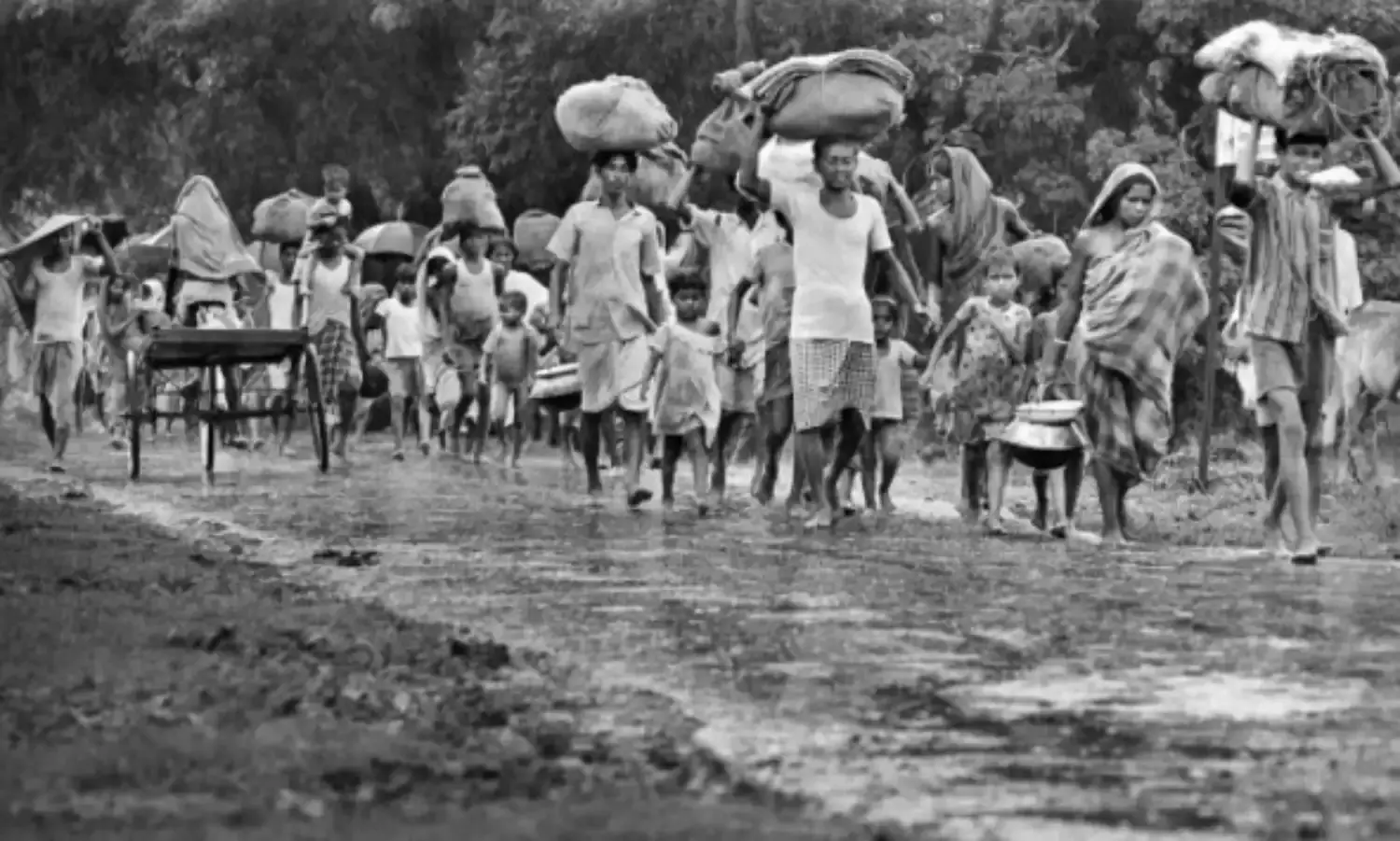
(A view from the Military Operations Directorate at the Indian Army HQ. You can read part 1 here.)
General AK Niazi had four divisions and sundry troops with him. Some Razakars and local loyalists were also used, but the bulk of the populace was against the Pakistanis. By the time the war started the local Mukti Bahini cadres had become fairly well trained and were a great asset to Indian troops, as were the bulk of the populace.
Niazi had decided on a fortress concept of defence, based on major towns and communication centres ahead of major rivers that abounded. He had thus covered all routes of ingress, which the Indian Army would have to reduce before advancing to the interior.
Accordingly, the important communication centres from west to east of Jessore, Jhenida, Bogra, Rangpur, Jamalpur, Mymensingh, Sylhet, Bhairab Bazar, Comilla and Chittagong were developed as fortresses. Being in depth, Dacca was left virtually undefended.
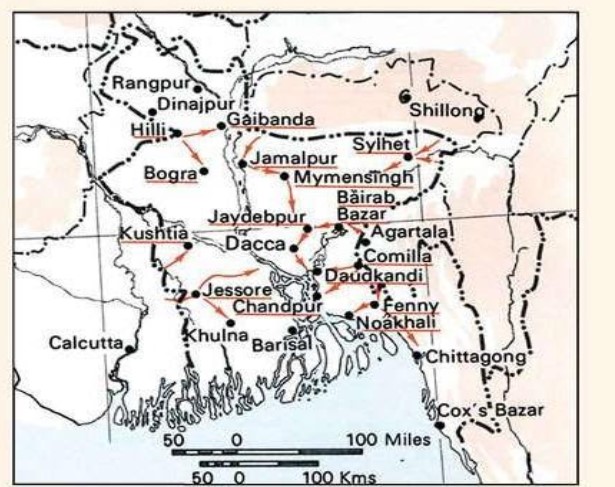
In the west, Pakistani 9 Infantry Division was to look after the South-Western Sector with its headquarters at Jessore, while Pakistani 16 Infantry Division was responsible for the North-Western Sector with its headquarters at Bogra.
In the east, Pakistani 14 and 39 Infantry Divisions were made responsible for the Eastern Sector with their headquarters at Ashuganj and Chandpur respectively.
Since little threat was expected from the north due to major rivers, only a brigade was allotted for the defence of Jamalpur-Mymensingh Sector, directly under a headquarters at Dacca.
Indian Order of Battle and Deployment
Since East Pakistan was surrounded by India on three sides, it was planned to launch offensives from all three sides with the fourth facing the sea being blocked by the Indian Navy. The two squadrons of the Pak Air Force were to be knocked out right at the start and air superiority achieved. Initial planning envisaged the securing of the river lines. However, the ultimate aim of securing Dacca and thus capturing the whole of East Pakistan only emerged as the offensives proceeded after the enemy’s defensive crust had been broken. Accordingly, the initial task given to HQ Eastern Command by Army HQ was to destroy Pakistani forces and occupy important areas in East Pakistan. These were later modified.
The areas assigned to Indian Army formations were II Corps in the south-western sector, XXXIII Corps in the north-western sector (with continued commitment for the Northern Border), 101 Communication Zone in the central-sector and IV Corps in the eastern-sector, plus an adhoc brigade size force named Kilo Sector for securing Feni from Southern Tripura.
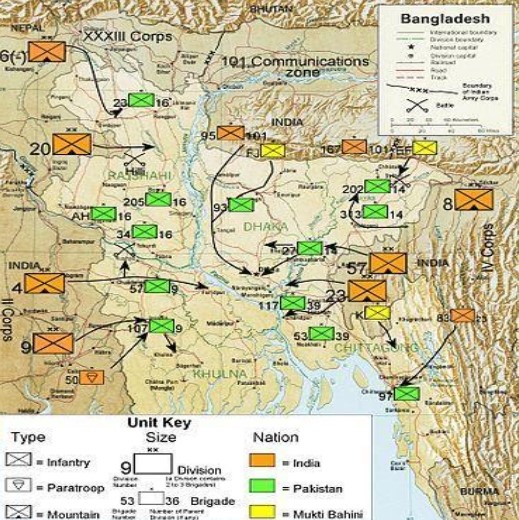
In addition, a hush hush operation under HQ Special Frontier Force (SFF), under the command of Maj Gen Uban was launched from Mizoram to the Chittagong Hill Tracts (CHT), primarily to capture any Pakistani personnel who may attempt to escape to Burma (now Myanmar). They were also tasked to threaten Chittagong.
Though India had an edge in numbers, the superiority was not large enough, being less than two to one. The only way the operations could be hastened was to evolve audacious plans that relied on manoeuvre and use of unconventional means. Risks had to be taken as it was envisaged that international pressure to stop hostilities would escalate, especially as the United States had decided to support Pakistan.
As mentioned earlier, the sea access/escape was blocked by the Navy. A battalion-sized amphibious operation to secure Cox’s Bazaar had also been planned and was launched in the closing stage of the war.
It had been planned to carry out an airdrop by a battalion at Tangail, where ‘Tiger’ Siddiqui, Mukti Bahini leader was located with about 20,000 Freedom Fighters. A parachute battalion was to link up with the Freedom Fighters and 95 Infantry Brigade advancing from the north, after which the combined force was to move towards Dacca.
Preliminary Operations
In November 1971 Indian troops were permitted to go into East Pakistan up to a depth of ten miles to silence enemy guns that had started shelling Indian border posts. These instructions were used to advantage by Indian troops to secure specific areas which helped in improving our offensive posture.
Most of the preliminary operations were completed before the commencement of hostilities on 03 December 1971. In the II Corps zone, both its Divisions had made gains. In the North-Western Sector of XXXIII Corps, parts of Hilli defences had been occupied but Hilli itself could not be captured, due to stiff resistance by the enemy. In the area of Dinajpur both banks of the Ichamati River were secured.
In the South-Eastern Sector, a number of important areas had been secured, which helped in launching speedy offensives after the war commenced.
In these preliminary operations, whenever attacks were launched against well prepared defences, the Pakistanis fought doggedly and did not give up easily. The attacks on Hilli defences in XXXIII Corps Zone are a good example. They had commenced on 23 November but the position was finally captured only on 11 December.
In the Central Sector, the garrison at Kamalpur had beaten back two attacks by restructured EBR units. It was finally secured only on 04 Dec.
Commencement of War
The Indo Pak war of 1971 began at 1740 hours on 3 December 1971, when the Pakistani Air Force bombed several Indian airfields in the Western Front. At 1800 hours General Manekshaw telephoned Major General Jacob, and asked him to notify Prime Minister Indira Gandhi, who was then in Calcutta. She flew back to Delhi the same night. The corps commanders had already been briefed on telephone and by 2030 hours HQ Eastern Command issued orders for commencement of the offensive. By daybreak on 4 December 1971 the Indian invasion of East Pakistan was fully underway.
Operations in II Corps Zone
Lt Gen T.N. Raina, MVC, was GOC II Corps. The divisional commanders under him were Major General Dalbir Singh (9 Infantry Division) and Major General M.S. Barar (4 Mountain Division). In addition, he had Major General P. Chowdry (Bengal Area) and Brigadier Mathew Thomas (50 Parachute Brigade).
Raina’s aim was to liberate territory west of the river Padma. He planned to do this by containing Pakistani strongholds near the border while fast-moving columns bypassed them and raced for the Madhumati River to prevent the bulk of the enemy from withdrawing across the river and making for the Meghna ferries to Dacca.
Two divisional thrusts, split into several columns were launched for the important communication centres at Jessore, Jhenida, Khulna, and Barisal and to cut the Khulna-Jessore-Kushtia railway to prevent the lateral move of the enemy.
Operations on XXXIII Corps Zone
Lt Gen M.L. Thapan was the GOC XXXIII Corps. Besides operations in East Pakistan, he was also responsible to hold the northern border against any attempts by China. He had under his command 20 Mountain Division (Major General Lachhman Singh, VrC) and 71 Mountain Brigade (Brigadier PN Kathpalia). At a later stage, 6 Mountain Division (Major General P.C. Reddy) was made responsible for the operations of 71 Mountain Brigade. The corps was also allotted 63 Cavalry less a squadron (T 55); 69 Armoured Regiment (PT 76) and 471 Engineer Brigade for the operations. Thapan employed 20 Mountain Division for securing Hilli-Gaibanda and thereafter for the capture of Bogra. 71 Mountain Brigade advanced to Dinajpur, for the subsequent capture of Rangpur.
Operations of 101 Communication Zone Area on Central Front
Maj Gen Gurbax Singh Gill was GOC 101 Communication Zone Area. The formation commanders under him were Brigadier H.S. Kler (PARA SIGNALS), Commander 95 Mountain Brigade and Brigadier Sant Singh (Commander FJ Sector). At a subsequent stage when it was clear that the northern border was calm, 167 Mountain Brigade under Brigadier Adi Irani (MARATHA LI) was also allotted to 101 Communication Zone Area.
The task assigned to Gen Gill was to capture Jamalpur-Mymensingh, followed by Tangail and thereafter establish contact with Dacca. These tasks were in addition to its normal commitments of providing logistic support to the formations in the region.
Gill utilised 95 Mountain Brigade to capture Jamalpur and FJ Sector to capture Mymensingh after the capture of Jamalpur.
Thereafter, a PARA Battalion was to be air-dropped at Tangail. An inland water transport task force was to move down from Dhubri to Jamalpur down the Brahmaputra River, to provide logistic support for the forces.
One battalion of 95 Mountain Brigade established a firm base north of Jamalpur. The other two battalions carried out wide outflanking moves and crossed rivers using country boats with the assistance of the locals. They established ‘Stops’ in the rear of the Jamalpur Garrison, after overcoming enemy resistance along the route. During this period, Maj Gen Gill was injured in a mine accident and had to be evacuated. Maj Gen G C Nagra, GOC 2 Mountain Division assumed command of 101 Communication Zone Area.
1 MARATHA L I (JANGI PALTAN), under the command of the dashing Lt Col ‘Bulbul’ Brar, after their long march on man pack basis and crossing many waterways had established themselves south of Jamalpur. Due to delay in the arrival of their heavy weapons, which were being carried on bullock carts, the road blocks were set up only in early hours of 9 December. I was keeping a special eye on the operations of this battalion as it was my battalion. It lived up to its nom-de-guerre of JANGI PALTAN, given over two hundred years back and picked up a number of gallantry awards as well as the Battle Honour JAMALPUR.
On 8 December, 167 Brigade under Brigadier Adi Irani (Maratha LI) was allotted to this force, but it could not reach in time to take part in the battle of Jamalpur.
The Jamalpur Garrison tried to break out but suffered a large number of casualties from the Marathas and the Indian artillery. Finally, early in the morning on 11 December the remnants of the garrison surrendered. The Marathas then advanced for the link-up with 2 PARA (MARATHA).
Operations on IV Corps Front
Lt Gen Sagat Singh was GOC IV Corps, with his headquarters at Teliamura in Tripura. The formations under his command were 8 Mnt Div (Maj Gen K.V. Krishna Rao), 57 Mtn Div (Maj Gen B.F Gonsalves), 23 Mnt Div (Maj Gen R.D. Hira, MVC) and Kilo Sector (Brig Anand Swarup). The corps was given the task of securing the area up to the line of Meghna River. Sagat Singh, being a bold commander, had his eyes on securing Dacca at the earliest.
In the 8 Mnt Div Sector, two thrust lines towards Sylhet were launched. Despite stiff resistance, Kulaura was secured on 06 Dec, followed by Brahman Bazar. On 07 Dec the advance was continued towards Fenchuganj. On the second thrust line Shamsher Nagar airfield was captured. After the capture of Munshi Bazar by the evening of 06 Dec, 10 Mahar took over the lead and contacted the outer defences of Maulvi Bazar the next day.
The Sylhet Helilift
In an audacious move, a helicopter-borne operation was launched on 7 December to seize Sylhet. As only nine Mi-4 helicopters were available, essential elements of the battalion along with two mountain guns were landed in phases over next two/three days. The enemy made some half-hearted attempts to attack and dislodge 4/5 Gorkha Rifles, but the battalion stood firm. Apparently, the noise of the helicopters misled the Pakistanis; it was later learned that they thought that an Indian brigade had landed.
Crossing the Meghna
The second and biggest heli-borne operation of the War commenced on 11 December when the mighty Meghna was crossed.
On 9 December, the corps commander after aerial recconasance decided to heli-lift his troops across the Meghna, and threaten Dacca.
The airlift began on the afternoon of the 9th and continued for the next 36 hours. A total of 110 sorties were flown from the Brahmanbaria stadium across the Meghna, which was 4000 yards wide, to land at helipads at Rajpura and Narsingdi.
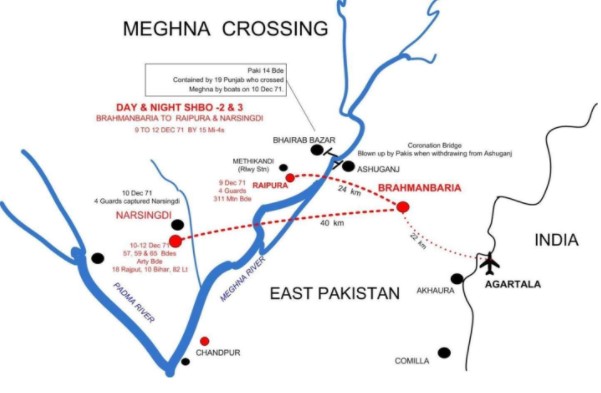
Meanwhile, another brigade had started to cross using boats. By 11 December, two Mountain Brigades had crossed the Meghna and were ordered to advance to Dacca, on different axes. Using all modes of transport, including bullock carts and cycle rickshaws, both brigades advanced rapidly, and on 14 December, the first artillery shell was fired on Dacca.
On 15 December, 311 Mountain Brigade was poised to enter Dacca, when orders were received from HQ Eastern Command to halt further advance.
On the night of 15/16 December, Dacca was subjected to shelling by artillery, and this hastened the surrender.

The two commanders who can be singled out for building and sustaining the offensive spirit and thinking ‘out of the box’ were GOC IV Corps-Lt Gen Sagat Singh and the Indian Air Force Commander-Air Commodore (later Air Marshal) Chandan Singh.
Gen Sagat's decision to cross the Meghna proved to be crucial to the entire operation. This was also the first instance in military history of an 'air bridge' being used for crossing a major water obstacle, by a brigade group.
Part 3 follows
Lt Gen Vijay Oberoi, PVSM, AVSM, VSM is an infantry officer (The Maratha Light Infantry) and a former Vice Chief of Army Staff. Despite losing his right leg in the 1965 India–Pakistan War, he soldiered on till his retirement in September 2001. A prolific writer and analyst, he was founder director of the Indian Army’s think tank, the Centre for Land Warfare Studies (CLAWS) for five years where he is now director emeritus. He is currently founder president of the War Wounded Foundation, set up for meaningful rehabilitation of war disabled personnel
